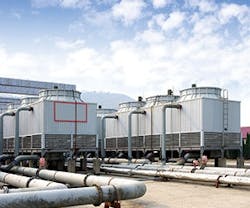Warmer temperatures herald the imminent arrival of the cooling season. Is your cooling tower ready to perform?
Now is a great time to tackle your annual to-do list for cooling tower maintenance. Make sure you adequately address both preventive maintenance needs: keeping Legionella from growing out of control and ensuring the tower’s continued physical integrity.
Ensure Good Legionella Control
Your spring startup will depend on your existing disinfection practices and whether you drained your cooling tower during shutdown. If you’re using a submersible UV lamp, it should be changed every year, notes microbiologist Dr. Robert Scheir, president of germicidal UVC provider Steril-Aire.
If you’re coming up on 12 months since the last time you changed the lamp, be sure to put in a new one – they lose output over time, Scheir notes.
As you replace the lamp, check to make sure it and the rest of the tower can function properly. Because Legionella can cost you so much money and bad PR, it’s paramount to make sure the bacteria are never allowed to grow out of control in the first place. This can be difficult because Legionella occurs naturally and isn’t a one-time problem that can be solved, Scheir explains.
Did you shut down your system long-term over the winter? If so, you should have drained the tower and other components, such as piping and heat exchangers, according to ASHRAE Guideline 12, which lays out a step-by-step startup process that minimizes Legionella risks.
If this is the case at your facility, clean any leaves, dirt, or other debris from the tower and fill the system with water. Before you operate the pumps, ASHRAE recommends that you use one of two approved biocidal treatments – either the biocide you were using before shutdown or sodium hypochlorite.
However, if the system is undrained and full of stagnant water, Guideline 12 recommends that you perform pretreatment directly in the cooling tower sump or remote storage tank.
Make absolutely sure that any biocides you’re using are registered with the EPA, as demonstrated by a label that includes a registration number and specific guidelines for use, notes William McCoy, chief technology officer for water management and testing firm Phigenics and the chair of ASHRAE’s committee for Standard 188P, which also addresses Legionella control.PageBreak
Inspect for Damage and Debris
No annual inspection is complete without a comprehensive examination of the tower’s physical condition.
Ideally, this starts in the fall with a thorough assessment to determine if the tower can last another year, explains Dan Glover, technical services group manager for Southland Industries, a national mechanical engineering, construction, and service firm.
However, it’s not uncommon to save this task for the spring, roughly a month or two before you plan to switch over to cooling. Common trouble spots include:
Basin: This is usually the first place you’ll spot major problems because the sediment will rust the metal parts, Glover notes.
“If you haven’t maintained that, you’ll have to replace the pan,” he adds. “Replacing the pan is almost as expensive as replacing the whole cooling tower.”
Fill: This plastic part is made to last about 10 years, but the stress of heat and cold exposure, constant moisture, and exposure to sunlight will break it down.
Nozzles: If you neglect them, clogs can become so bad that the nozzles themselves have to be replaced, Glover says.
Structural integrity: “Once the structure rusts out, it’s done,” Glover explains. “It’s best to keep it painted with a zinc paint.”
As you inspect, look for signs or potential causes of scale and corrosion, such as these red flags noted in the OSHA Technical Manual:
- Visible buildup of scale, sediment, or bio-fouling (accumulated biological material)
- Presence of rust or scale in the water, which could indicate infrequent use, corrosion, or biofilm formation
- Free residual chlorine above 1 part per million, which can corrode metals in the system, react with any organic substances in the water to form toxic byproducts, and damage any wood in the tower
- A pH above 8.0
Also look for damage from environmental causes, especially if your facility is in an urban area with polluted air, Glover recommends.
“Garbage in, garbage out. If you’ve got contaminated air, your cooling tower is breathing it, and that’s going to attack your tower,” Glover explains. “I once worked on a building with diesel trains sitting next to it. The diesel smoke got into the cooling tower and caused iron-reducing bacteria to grow and eat away at the piping – they thrive in environments that contain a lot of petroleum.”
The Bottom Line
It’s easy to overlook periodic maintenance if your water testing and physical examination both indicate a healthy cooling tower, but that attitude can be harmful to occupants and the tower itself.
Fortunately, with a watchful eye and routine preventive maintenance, you can keep your tower running efficiently and occupants healthy for years to come.
Keeping the tower in good shape and preventing Legionella are as simple as preventing food poisoning, McCoy adds. Effective practices are widely known, but you actually have to use them to avoid illness. The same attitude applies to maintaining the tower’s physical integrity.
“You can’t eliminate food poisoning – if you buy hamburger, leave it to sit for a couple of days, and then don’t cook it properly, you’re going to get sick. The only way to prevent disease is to handle the food properly,” McCoy says. “Handle the water properly and use a risk management system that is scientifically based and reliable.”
Janelle Penny [email protected] is associate editor of BUILDINGS.
About the Author
Janelle Penny
Editor-in-Chief at BUILDINGS
Janelle Penny has been with BUILDINGS since 2010. She is a two-time FOLIO: Eddie award winner who aims to deliver practical, actionable content for building owners and facilities professionals.

